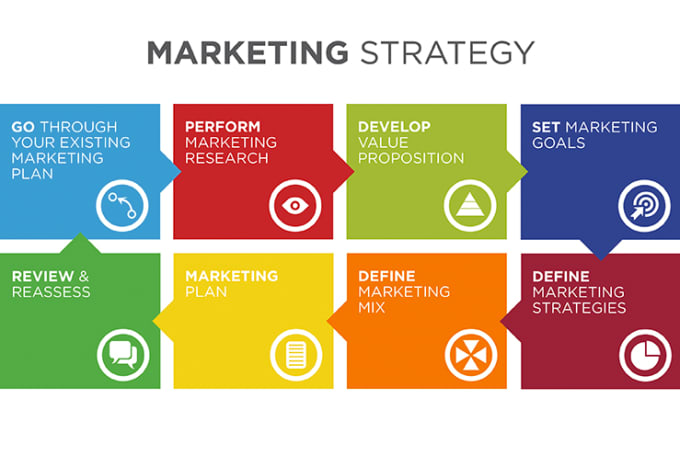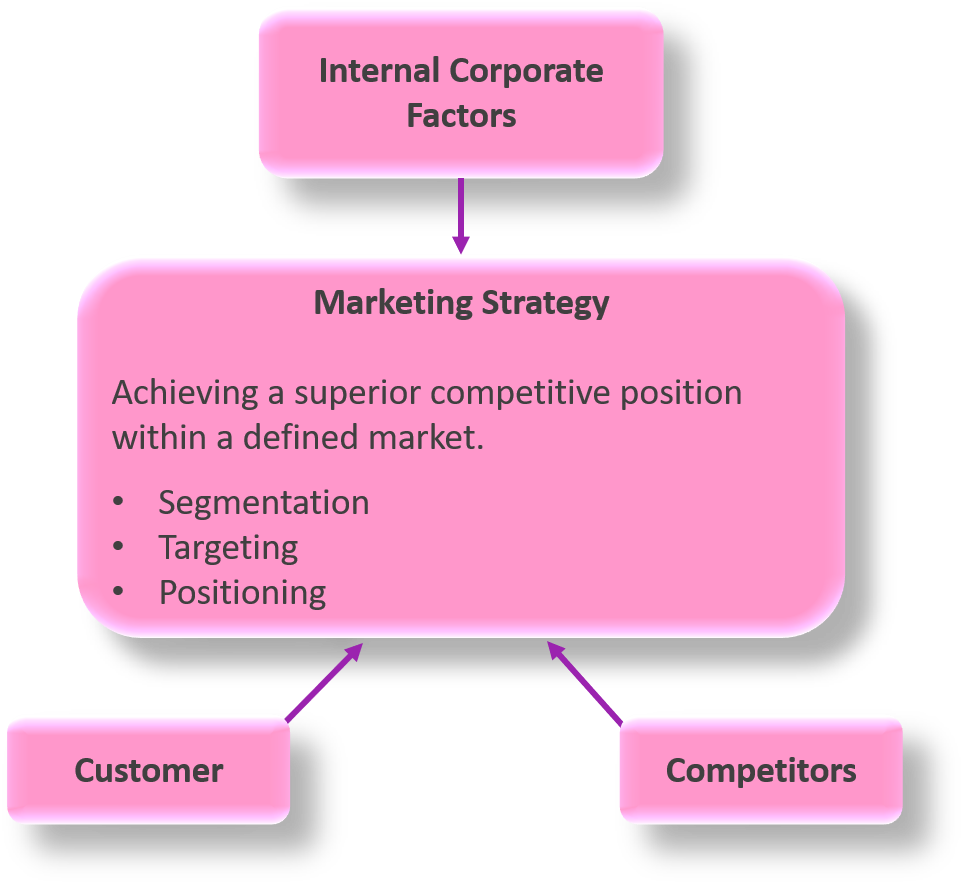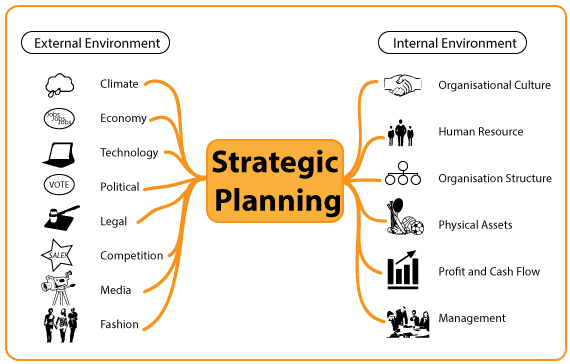Strategy must address issues such as customers, competitors, and market trends. It needs to be proactive as opposed to simply reacting to events. In this way, strategy can detect and influence changes in the business environment. By its nature, marketing defines how the organisation interacts with its market place. Consequently, all strategic planning, to a greater or lesser degree, requires an element of marketing. Only in this way can organisations become strategically responsive to customer need and commercial pressures. Indeed, it is possible to view marketing as more than a functional activity. It can be adopted as a business philosophy. Here the organisation adopts a marketing orientation – success by a process of understanding and meeting customer needs.
The company’s orientation defines its fundamental business philosophy, highlighting what is perceived as the primary route to success. Market orientations are now widely established within the business world (and often seen as the ‘holy grail’ of marketers) but other business orientations are equally common.

Production orientation: Here, business success is attributed to efficient production. The emphasis is on mass production, economy of scale, and cost control. Management’s key concern is with achieving volume and meeting production schedules. This philosophy has its place, but risks limiting operations to low added-value assembly work.
Product orientation: The belief is that product innovation and design will have buyers beating a path to our door. Management’s perception is that our products are so good they will, in effect, sell themselves. Little, or no effect, is put into establishing what the customer actually wants – a dangerous route! Naturally, product innovation is important, but it needs to appeal to the market place, otherwise it risks being innovation for the sake of innovation.
Sales orientation: This views sales volume as the key determinant of success. The focus is on aggressive selling that persuades the customer to buy. Given that the process is driven by sales targets, a short-term perspective dominates with little regard to building longer-term relationships. Often, this follows on from a production orientation, as management tries to create a demand for unwanted products.
Market orientation: As previously said, success is derived from understanding and meeting customer needs. This process starts with the customer and uses actual customer demand to focus resources. In simple terms, we provide what the market wants. Additionally, the importance of building long-term relationships with customers is recognised. We seek to build loyalty and consistently offer superior value. An awareness of competitors’ proficiency and strategy is required in order to optimise this process.
How do we go about achieving a market orientation? The answer to this question can be summarised as follows:
Customer Focused
Understand your customer base and be responsive to their needs. Treat loyal customers as assets and strive to build on-going and long-term relationships. Regularly check levels of customer satisfaction and retention. To achieve this, we must:
- define our markets,
- effectively segment/target customers, and
- listen to customers.
Competitor Focused
In terms of competitors, be watchful and assess their goals, strategies, and capabilities. There is the need to ‘benchmark’ their products, processes, and operations against our own.
Integrate Marketing into The Business
Marketing should not be confined to the marketing department. Every function and person within the organisation have a role to play in creating value and achieving the goal of being a market-led organisation. This may require fundamental changes in culture and organisation structure.
Strategic Vision
Develop a long-term, market-orientated strategic vision by viewing marketing as more than a series of promotional tools and techniques. It must be on the agenda of senior management, who should develop and implement market-led strategy and define the future in terms of creating long-term value for stakeholders.
Realistic Expectations
We cannot be all things to all people. Expectations must be realistic and matched to capabilities, resources and external conditions. We may well need to make ‘trade-offs’ to ensure we focus on activities that add value.
Realistic Expectations
We cannot be all things to all people. Expectations must be realistic and matched to capabilities, resources and external conditions. We may well need to make ‘trade-offs’ to ensure we focus on activities that add value.

Strategically, marketing aims to transform corporate objectives and business strategy into a competitive market position. The concern is to differentiate our actives/products by meeting customer needs more effectively than competitors. Marketing strategy can by characterised by:
- analysing the business environment and defining specific customer needs,
- matching actives/products to customers segments, and
- implementing programmes that achieve a competitive position superior to competitors.
Therefore, marketing strategy addresses three elements: customers, competitors and internal corporate issues.


Firstly, we consider customers. How is the market defined, what segments exist and who should we target? Secondly, how can we best establish a competitive position? A precursor to this is a detailed understanding of our competitors within targeted market segments. Finally, we need to match internal corporate capabilities with customer needs. The successful achievement of these factors should enable the organisation to develop and maintain a strong market position.
A marketing strategy aims to deliver the following:
Segmentation
This process divides the market into groups displaying common characteristics, behaviours and attitudes. Fundamentally, this process aims to understand need and forecast reaction and/or demand.
Targeting
This involves evaluating and selecting market segments. We aim to look for opportunities which are sustainable, where we can build long-term relationships with customers.
Positioning
As previously stated, we establish a distinctive superior position, relative to competitors. The competitive position adopted should be based on matching product attributes to customer need.
It is obvious that the three key constituents of marketing strategy – customers, competitors, and internal corporate factors – are dynamic and constantly changing.
Therefore, organisations must develop and deploy processes, procedures and techniques that ensure market strategy are:
- relative to the current/future business environment,
- sustainable,
- generating optimal benefits to both the organisation and customers, and
- correctly implemented.
This is the process of strategic marketing management. As a process, strategic marketing has three distinct phases.
Strategic Analysis
To move forward, we must first answer the question ‘where are we’? This stage entails a detailed examination of the business environment, customers, and an internal review of the organisation itself. Tools such as portfolio analysis and industry structure models help management to objectively assess the organisation’s current position. Equally, it is important to develop some view about future trends. This is achieved through forecasting and defining assumptions about the future market trends.
Formulating Strategy
Having analysed our situation, we then determine a way forward. Formulation involves defining strategic intent; what are our overall goals and objectives? Managers need to formulate a marketing strategy that generates competitive advantage and positions the organisation’s products effectively. To be successful, this must be based on core competencies. During this stage, product development and innovation are strategic activities, offering the potential to enhance competitive positions and further develop products and brands.
Additionally, formulation emphasises the need to form relationships with customers and other businesses. Increasingly, we see organisations recognising that they cannot do everything themselves and look to form joint ventures and partnerships. The formulation stage culminates with the development of a strategic marketing plan.
Implementation
Consideration needs to be given to implementing the strategy. Marketing managers will undertake programmes and action that deliver strategic goals. Such actions will often focus on individual elements of the marketing mix. Additionally, a process of monitoring and control needs to be put in place. This ensures compliance and aids decision-making.
